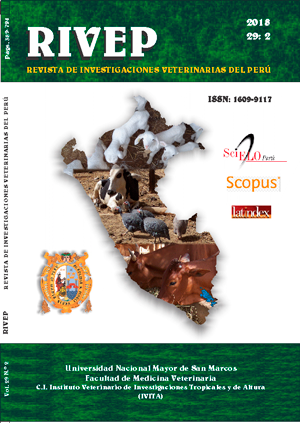Technological characteristics of the fibre of vicuñas in semi-captivity of the Multicommunal Picotani - Puno region
DOI:
https://doi.org/10.15381/rivep.v29i2.14475Keywords:
vicuña, fiber, Picotani, fineness, length, stapleAbstract
The aim of this study was to determine staple and fibre length, as well as the fibre diameter of vicuñas by age (cria, juvenile and adults) and sex (male and female). The study was carried out in the semicaptivity vicuña farm of Multicomunal Picotani, Puno, Peru, located between 4420 and 4800 m above the sea level. Response variables were analyzed in a factorial arrangement of 2x3 conducted in a completely radomized design. The mean staple length was 3.03 ± 0.52 and 2.97 ± 0.51 cm for males and females (p>0.05) and 3.08 ± 0.47, 3.33 ± 0.39 and 2.59 ± 0.39 cm for crias, juveniles and adults respectively (p<0.05). The fibre length was 4.13 ± 0.53 and 4.06 ± 0.55 cm in males and females (p>0.05) and 4.22 ± 0.28, 4.57 ± 0.27 and 3.50 ± 0.34 cm for crias, juveniles and adults respectively (p<0.05). The fibre diameter was 12.755 ± 0.580 and 12.719 ± 0.398 ìm for males and females (P>0.05), and 12.359 ± 0.352, 12.856 ± 0.442 and 12.997 ± 0.447 μm for juveniles and adults, respectively (p<0.05). The variables in the study did not show significant differences for the sex factor, while the juvenile vicuñas recorded the greatest staple and fibre length, and the crias had the greatest fineness (p<0.05).Downloads
Downloads
Published
Issue
Section
License
Copyright (c) 2018 Jesús E. Quispe Coaquira, Teófilo Herrera Mamani, Edgar Apaza Zúñiga, Ludwin Clavetea Quisca, Zenón Maquera Marón

This work is licensed under a Creative Commons Attribution-NonCommercial-ShareAlike 4.0 International License.
AUTHORS RETAIN THEIR RIGHTS:
a. Authors retain their trade mark rights and patent, and also on any process or procedure described in the article.
b. Authors retain their right to share, copy, distribute, perform and publicly communicate their article (eg, to place their article in an institutional repository or publish it in a book), with an acknowledgment of its initial publication in the Revista de Investigaciones Veterinarias del Perú (RIVEP).
c. Authors retain theirs right to make a subsequent publication of their work, to use the article or any part thereof (eg a compilation of his papers, lecture notes, thesis, or a book), always indicating the source of publication (the originator of the work, journal, volume, number and date).



